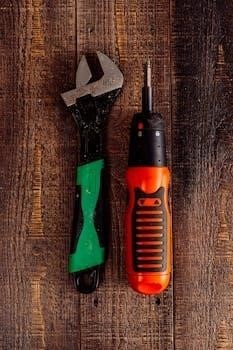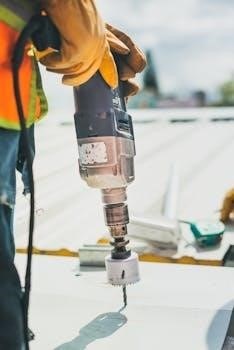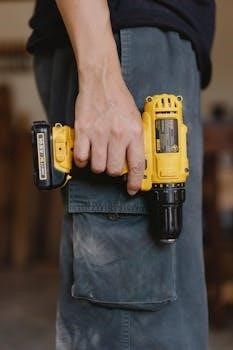
Electric Scooter Repair Manual PDF⁚ A Comprehensive Guide
An electric scooter repair manual PDF serves as an invaluable resource, offering essential maintenance tips to keep your scooter in optimal condition. These manuals guide users through tasks like checking tire pressure and tightening bolts, helping save money on repairs and ensuring smooth scooter operation.

Understanding the Importance of a Repair Manual
An electric scooter repair manual is crucial for maintaining and repairing your electric scooter, ensuring its longevity and optimal performance. These manuals provide detailed instructions, diagrams, and troubleshooting guides, enabling owners to perform routine maintenance and address common issues effectively. By consulting a repair manual, you can proactively care for your scooter, preventing potential problems and extending its lifespan.
Repair manuals empower users to diagnose and fix problems independently, saving time and money on professional repairs. They offer step-by-step instructions for various tasks, from battery maintenance to motor troubleshooting, providing a comprehensive understanding of your scooter’s mechanics. With a repair manual, you can confidently tackle repairs, ensuring your scooter remains in top condition.
Furthermore, repair manuals emphasize safety precautions, ensuring users are aware of potential hazards and proper procedures during maintenance and repairs. They provide guidance on using the correct tools and techniques, minimizing the risk of injury or further damage to the scooter. By following the guidelines in a repair manual, you can safely and effectively maintain your electric scooter, enjoying its benefits for years to come. Accessing repair FAQs can also resolve a lot of questions.
Types of Electric Scooter Repair Manuals (PDF, Online, Physical)
Electric scooter repair manuals come in various formats to suit different preferences and needs. PDF manuals are a popular choice, offering digital accessibility and easy searchability. They can be downloaded and viewed on computers, tablets, or smartphones, making them convenient for on-the-go reference. Online repair manuals provide interactive guides, often with videos and user forums for collaborative troubleshooting.
Physical repair manuals, typically in book form, offer a tangible resource for those who prefer a traditional approach. These manuals often contain detailed diagrams and illustrations, providing a comprehensive visual guide to scooter components and repair procedures. Each format has its advantages, catering to different learning styles and access requirements.
The choice between PDF, online, and physical manuals depends on individual preferences and the specific repair task. PDF manuals are ideal for quick reference and portability, while online manuals offer interactive support and community engagement. Physical manuals provide a comprehensive and tactile learning experience. Regardless of the format, a repair manual is an essential tool for any electric scooter owner.
Identifying Your Scooter Model for Manual Compatibility
Before attempting any repairs on your electric scooter, it’s crucial to identify the exact model. Repair manuals are typically model-specific, providing instructions and diagrams tailored to the unique design and components of a particular scooter. Using the wrong manual can lead to incorrect procedures and potential damage. Start by locating the scooter’s model name and number, usually found on a sticker or plate affixed to the frame, often near the battery compartment or under the deck.
Once you have the model information, verify the manual’s compatibility. Check the manual’s title or description to ensure it matches your scooter’s make and model. Some manuals cover a range of models within a brand, so carefully compare the specifications and features outlined in the manual with those of your scooter. If you’re unsure, consult the manufacturer’s website or contact their customer support for assistance.
Using a repair manual that doesn’t match your scooter model can result in confusion and potentially harmful repair attempts. Double-checking compatibility ensures that you have the correct information and guidance for a successful repair.
Essential Tools and Equipment for Electric Scooter Repair
To effectively tackle electric scooter repairs, assembling a collection of essential tools and equipment is paramount. A basic toolkit should include a set of screwdrivers (Phillips head and flathead) in various sizes to accommodate different screws found throughout the scooter. Allen wrenches (hex keys) are also crucial, as they are commonly used for securing components like handlebars and wheels.
A multimeter is indispensable for diagnosing electrical issues, allowing you to test voltage, current, and resistance. Pliers (needle-nose and standard) are useful for gripping, bending, and cutting wires. Wire strippers and crimpers are necessary for working with electrical connections. A socket set can be handy for tightening nuts and bolts.
Additional helpful items include zip ties for cable management, electrical tape for insulation, and a lubricant like WD-40 for loosening stubborn parts. A workbench or stable surface provides a comfortable and organized workspace. Safety glasses and gloves are essential for protecting yourself during repairs. Having the right tools not only makes repairs easier but also ensures safety and prevents damage to the scooter.

Basic Troubleshooting⁚ Battery and Power Issues
When your electric scooter fails to power on, the battery is the first suspect. Begin by visually inspecting the battery for any signs of damage, such as swelling or leaks. Use a multimeter to check the battery’s voltage; it should match the manufacturer’s specifications. If the voltage is significantly lower, the battery may be depleted or faulty.
Next, examine the charging port and cable for any damage or loose connections. Ensure the charger is functioning correctly by testing it with another device if possible. If the battery charges but the scooter still doesn’t power on, check the fuse or circuit breaker. A blown fuse can easily be replaced.
Inspect all wiring connections from the battery to the motor controller, looking for loose or corroded terminals. Clean any corrosion with a wire brush and ensure connections are secure. If the scooter has a power switch, test it with a multimeter to confirm it’s functioning correctly. Sometimes, simply pushing the scooter to start can help diagnose issues with the motor or controller.
Troubleshooting Motor Problems
Electric scooter motor problems can manifest in various ways, including a complete lack of power, reduced performance, or unusual noises. Start by checking the motor’s wiring connections for any looseness or damage. Ensure all connectors are securely plugged in and free from corrosion. Use a multimeter to test the voltage reaching the motor; it should match the battery’s output.
If the motor is receiving power but not spinning, inspect the motor’s internal components. This may require disassembling the motor, which should only be done if you are comfortable with electronics repair. Look for signs of wear or damage on the brushes (if the motor has them) and the commutator. Replace worn brushes or clean the commutator with fine sandpaper.
Listen for unusual noises coming from the motor. Grinding or squealing sounds may indicate worn bearings or internal damage. Check the motor’s alignment and mounting to ensure it’s properly secured. If the motor is overheating, it could be a sign of excessive friction or a failing controller. Consider consulting a repair manual specific to your scooter model for detailed troubleshooting steps.
Brake System Maintenance and Repair
Maintaining your electric scooter’s brake system is crucial for safety. Regularly inspect brake pads for wear and tear; replace them when they become thin. For disc brakes, check the rotor for damage or warping, and ensure calipers are properly aligned. Clean brake components with a suitable cleaner to remove dirt and debris, which can reduce braking efficiency.
Adjust brake cable tension to ensure responsive braking. If brakes feel spongy, bleed the brake lines to remove air bubbles. Hydraulic brake systems require periodic fluid changes, so consult your repair manual for proper procedures. Inspect brake levers for damage and ensure they move freely.
For electric brakes, check wiring connections and sensor alignment. Test the brake cutoff switch to ensure it disengages the motor when brakes are applied. If you encounter issues with electronic braking, refer to your scooter’s manual for troubleshooting steps. Proper brake maintenance ensures safe stopping power and prolongs the life of your scooter.
Tire and Wheel Maintenance and Replacement
Proper tire and wheel maintenance is essential for a smooth and safe electric scooter ride. Regularly check tire pressure to ensure it matches the recommended PSI listed on the tire sidewall. Underinflated tires can reduce range and increase the risk of punctures, while overinflated tires can compromise grip;

Inspect tires for wear, cuts, and embedded objects. Replace tires when the tread is worn down or if you notice significant damage. When replacing tires, use the correct size and type specified by the manufacturer. Tubeless tires may require sealant to prevent leaks.
Check wheel alignment and tighten any loose spokes. Inspect wheels for cracks or damage. Replace bent or damaged wheels immediately. Ensure wheel bearings are properly lubricated for smooth rotation. Clean wheels regularly to remove dirt and debris. Balancing your wheels after tire replacement can improve stability and reduce vibrations. Proper tire and wheel maintenance enhances your scooter’s performance and extends its lifespan.
Wiring and Electrical Component Inspection
Regular inspection of wiring and electrical components is crucial for maintaining the performance and safety of your electric scooter. Begin by visually examining all wires for signs of wear, fraying, or damage. Check connections to ensure they are secure and free from corrosion. Loose or corroded connections can lead to intermittent power issues or complete failure.
Inspect the battery pack for any signs of swelling, leakage, or damage. Use a multimeter to test the voltage of the battery and other electrical components to ensure they are within the specified ranges. Check fuses and circuit breakers for continuity and replace any that are blown or tripped.
Pay close attention to the wiring harness, ensuring it is properly routed and secured to prevent chafing or pinching. Inspect the motor connections and controller for any signs of overheating or damage. If you notice any unusual smells or smoke, immediately disconnect the battery and seek professional assistance. Proper wiring and electrical component maintenance ensures reliable and safe operation of your electric scooter.
Frame and Body Repair Techniques
Addressing frame and body damage is vital for maintaining the structural integrity and aesthetic appeal of your electric scooter. Minor scratches and cosmetic blemishes can often be repaired with touch-up paint or specialized plastic repair kits. For more significant damage, such as dents or cracks, more advanced techniques may be required;
Begin by thoroughly cleaning the damaged area to remove any dirt, debris, or rust. Use body filler to repair dents and smooth out imperfections. Sand the filled area to match the surrounding surface. Apply primer and paint to restore the original finish. For cracked or broken plastic components, consider using plastic welding or epoxy adhesives to bond the pieces together.
If the frame is bent or damaged, it may require professional repair or replacement. Ensure that all frame components are properly aligned and securely fastened. Regularly inspect the frame for signs of stress or fatigue, especially around welds and joints. Proper frame and body repair not only improves the scooter’s appearance but also ensures its safety and longevity.
Safety Precautions When Working on Electric Scooters
Prioritizing safety is paramount when performing any maintenance or repair work on electric scooters. Always disconnect the battery before beginning any repairs to prevent accidental electrical shocks or short circuits. Wear appropriate safety gear, including eye protection, gloves, and closed-toe shoes, to protect yourself from potential hazards.
Work in a well-ventilated area to avoid inhaling fumes from cleaning agents, solvents, or adhesives. Use the correct tools for the job and ensure they are in good working condition. Never force components or use excessive force, as this can cause damage or injury. Be mindful of sharp edges and pinch points.
If you are unsure about any repair procedure, consult a qualified technician or refer to the repair manual for detailed instructions. When working with electrical components, be cautious of high-voltage areas and follow proper wiring techniques. After completing the repairs, double-check all connections and ensure that all safety features are functioning correctly. Taking these precautions will help ensure a safe and successful repair experience.
Finding Reliable Repair Manuals and Resources Online
Locating credible repair manuals and resources online is crucial for effective electric scooter maintenance. Start by identifying the exact make and model of your scooter, as this will help narrow your search to compatible manuals. Official manufacturer websites are often the best source for accurate and up-to-date information.
Look for repair manuals in PDF format, as they are easily accessible and can be downloaded for offline use. Online forums and communities dedicated to electric scooters can also provide valuable insights and troubleshooting tips. However, exercise caution when using information from unofficial sources, as it may not be accurate or reliable.
Cross-reference information from multiple sources to ensure consistency and accuracy. Consider investing in a reputable repair manual from a trusted publisher. When searching online, use specific keywords such as “electric scooter repair manual PDF” followed by your scooter’s make and model. Always prioritize safety and consult with a qualified technician if you have any doubts about a repair procedure.


